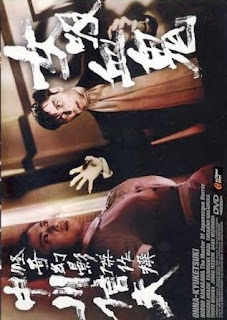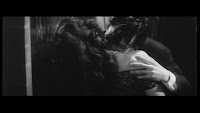Director: Nobuo Nakagawa
Release date: 1959
Contains spoilers
Onna kyûketsuki is variously known as the Woman (or Lady) Vampire and Vampire Man and is not only an example of a very early take on vampires from Japanese cinema but also, I believe, the first Japanese horror film set in contemporary times.
The film doesn’t generate the atmosphere it should (after quite a promising start) and its lore is rather unusual. But it is exactly those unusual aspects that make it so interesting.
Tamio (Keinosuke Wada) is a reporter for a newspaper, who is being driven to a party. A figure walks into the road and the car swerves and skids to a halt. The driver is convinced he hit her but the woman has vanished. Meanwhile the party, a birthday party for Tamio’s fiancée Itsuko (Junko Ikeuchi), is in full swing and the reporter is late. Unable to wait she cuts her cake and slices her finger.
Tamio arrives and sees the figures in the house grounds, but she vanishes again. He explains this to Itsuko whilst the butler, Wada (Hiroshi Sugi), says to Itsuko’s father (Torahiko Nakamura) that his wife vanished after cutting her finger twenty years ago. We see the figure moving through the house and then the power cuts. The butler hears a bell – from a room sealed for twenty years. When we see him moving through the house we witness some truly atmospheric cinematography – unfortunately the rest of the film does not match it.
The father goes into the sealed room and exclaims "Miwako" (Yôko Mihara). It is his wife and she has not aged. She seems comatose and he mentions the Amakusa Curse (we’ll come back to that). The next day the doctor can’t explain her comatose state or lack of aging. Tamio promises not to write about the events and takes Itsuko to an art gallery to see a competition. The winning artist is the mysterious Shiro Sofue (Shigeru Amachi) and the painting is of Miwako. Itsuko is approached by a man in shades, who we realise is Shiro – also known as Takenaka. He leaves accompanied by a dwarf, Tiny (Tsutomu Wakui).
That night Tiny goes to the gallery. Later in the film we realise that he has stolen the painting and delivered it to Itsuko’s father and the painting jolts Miwako out of her comatose state. However, at this point we see him return to Takenaka's hotel. He enters the room via a vent when Takenaka suddenly realises that the curtains are open and he panics. They are unable to close them in time and he sees the moon – this causes him pain and forces his transformation into full vampiric mode.
There are overtones of both lycanthropy and Jekyll and Hyde in this scene. It is clear that the moon has an uncanny effect on him (later we hear that he fears the moon) and that also fits loosely in with pre-Stoker vampire lore. A maid enters the room and he claws at her neck, killing her. Later he dumps her body outside the room and he becomes a witness for the police due to the fact his room is near to where she is found.
Story wise I do not wish to go further into this but I do want to look at the lore (and back story) in some depth. We have the moon effects and he seems – in his underground castle-like lair – to have several monster servants, of which Tiny is one. What they are exactly is unclear but Tiny seems less than obedient. When Takenaka is caught out by the moon the next night, and hides in a bar, Tiny goes mental, smashing bottles and flinging them around.
This subsequently leads to a broken window and a full on transformation before the moon and it does appear that this was Tiny’s goal. Takenaka then goes on a killing spree and the newspapers report that he kills six women that night – certainly the three we see are killed by biting the neck. This makes us wonder whether the failure to close the curtains, the night before, might have been a deliberate act on Tiny's part also.
As for the curse, it is barely mentioned in itself but the actual backstory (revealed in a flashback) shows Miwako to be the descendant of Amakuso Shiro. Amakuso was an actual historical figure and the Shimabara Uprising that is mentioned was an actual event, where Tokugawa Lemitsu – leader of the Tokugawa Shogunate – put down the uprising of which Amakusa was the leader. The rebels were Christians. In the film Takenaka was a samurai dedicated to the Princess Katsu (also Yôko Mihara). He kills her to spare her capture, as the moon rises, and then drinks her blood – hence the curse.
Miwako is identical to her and was lured to Takenaka with the scent of a flower when he kidnapped her. He offers eternal life to a woman he clearly recognises as Katsu in return for her love. I found this potentially reincarnated love interesting as, whilst the earliest example I have come across is in the short story I, the Vampire (available in the book Weird Vampire Tales), this film predated Dan Curtis using reincarnated love as a device in Dark Shadows by several years. Anyway, it subsequently takes her twenty years to escape. He also threatens her with the golden cross – and this is interesting from a genre point of view. Takenaka uses the cross (rather than is repelled by it) and it will turn a woman forced to wear it into an eternal statue. He has done this several times before.
The last thing to mention may connect with the curse – though the connection is not that explicit. Takenaka dies after rapidly aging (or so it looks, it could just be a case of growing monstrous) and this seems tied in with him denying the strictures of the curse. The sunken castle (for want of a better description) is also destroyed in this sequence – as though he and the fortress are somehow connected and Tamio seems to think, after all this, that the curse is lifted but the film is infuriatingly silent on the nuances.
The film has interesting vampire lore but I was frustrated by lack of exposition as to what the monsters were. The ending drags on and, to be honest, gets a tad silly. However, this is an important piece of vampire cinema – especially as a piece of Japanese cinema. 5.5 out of 10.
The imdb page is here.
Amazon link for DVD here
Friday, July 09, 2010
Subscribe to:
Post Comments (Atom)

























2 comments:
This looks like my kind of film. I am going to search for this one and the previous post as well, La Senora Muerte. I have a bunch of mexcian horror and wrestling films I need to sit down and watch. If I can find these I may review them myself.
As a always thanks for the education.
Bill
Bill thanks for stopping by, always good to hear from you.
Post a Comment